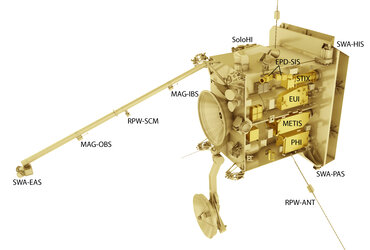Software at the service of space science
Peter van der Plas, software engineer
Each interplanetary mission that ESA flies carries a multitude of instruments. These spacecraft are headed to pretty inaccessible deep space destinations, so the aim is always to survey as many different aspects of these target environments as possible.
Usually each one of these instruments is contributed by the scientific community – designed by universities or research institutes and overseen by a senior scientist termed a ‘Principal Investigator’. Rosetta, for instance, had 11 different instruments on the orbiter, plus another seven on its lander.
The actual operation of these instruments has to be planned carefully, because they can’t all be operated together at the same time. Each one will have particular – and potentially clashing – requirements in terms of spacecraft pointing direction, Sun illumination, power consumption, thermal constraints, mass memory usage and downlink to Earth. Instrument use also needs to fit in with the operation of the spacecraft platform, which is overseen from ESOC in Darmstadt, Germany. It adds up to a very complicated planning challenge, to avoid squandering promising observing opportunities, or actually losing already acquired data due to memory or downlink bottlenecks.
So back at the turn of the century, our team at ESA’s Software Systems Division conceived a multi-mission software system called the Mission Analysis and Payload Planning System (MAPPS) to assist with science operations planning. MAPPS is basically a planning and simulation tool to assist with the complex process of instrument operation scheduling, which is overseen by ESA’s mission science operations teams based at the ESAC facility near Madrid.


Access the video
The software enables advanced planning of instrument use, including the extensive simulation and modelling of their use to pinpoint any conflicts or problems arising. The end result is a consolidated multi-instrument operational timeline that can actually be carried out, and is then uplinked to the spacecraft. Often smaller instrument teams are also making use of MAPPS as well, if they do not have their own planning software. The software has evolved over the years; its display has switched from 2D to 3D visualisation, which has proved useful to plan activities such as atmospheric limb observation, or for operating around Rosetta’s rubber-duck-shaped target comet.
The initial impetus for MAPPS came from anticipating the needs of Rosetta, although that mission included a ten-year cruise phase before it needed its final destination. MAPPS was however useful for the planetary and asteroid flybys that Rosetta performed enroute. And there was another mission that MAPPS was able to serve: ESA’s Smart-1 mission to the Moon was primarily conceived of as a technology demonstrator, but MAPPS helped maximise its scientific return. The system was also employed by Venus Express – a relatively fast turnaround mission, a copy of Mars Express.
Then in 2009 MAPPS began serving Mars Express itself during its extended mission. Then in 2014 MAPPS got down to routine work with the mission it had first been designed for, when Rosetta finally entered orbit around comet 67P/Churyumov–Gerasimenko. We reached a body we didn't know anything about, then had to learn how to fly around it while also planning for the imminent Philae landing. That was a tough time for everyone, with so many different things going on, and MAPPS helped the science operations planners bear the load.
MAPPS has built up a lot of capabilities – like the software equivalent of a Swiss army knife
Working with all these diverse missions, MAPPS has built up a lot of capabilities – like the software equivalent of a Swiss army knife. It is more than 15 years old now, and due to leave home. The plan is that the system plus key members of the development will be moving to ESAC, to be overseen by our colleagues in the Science Directorate. So a system conceived, built and evolved here in ESTEC have a new home, and our role will be less hands-on, and more advisory.
MAPPS will certainly go on developing, to meet the needs of ESA’s coming missions to the Solar System: the ExoMars Trace Gas Orbiter – once its aerobraking manoeuvres are concluded to settle down to scientific work – plus BepiColombo, Solar Orbiter and JUICE, the Jupiter Icy Moons Explorer, and other planetary missions to come.














 Germany
Germany
 Austria
Austria
 Belgium
Belgium
 Denmark
Denmark
 Spain
Spain
 Estonia
Estonia
 Finland
Finland
 France
France
 Greece
Greece
 Hungary
Hungary
 Ireland
Ireland
 Italy
Italy
 Luxembourg
Luxembourg
 Norway
Norway
 The Netherlands
The Netherlands
 Poland
Poland
 Portugal
Portugal
 Czechia
Czechia
 Romania
Romania
 United Kingdom
United Kingdom
 Slovenia
Slovenia
 Sweden
Sweden
 Switzerland
Switzerland




























